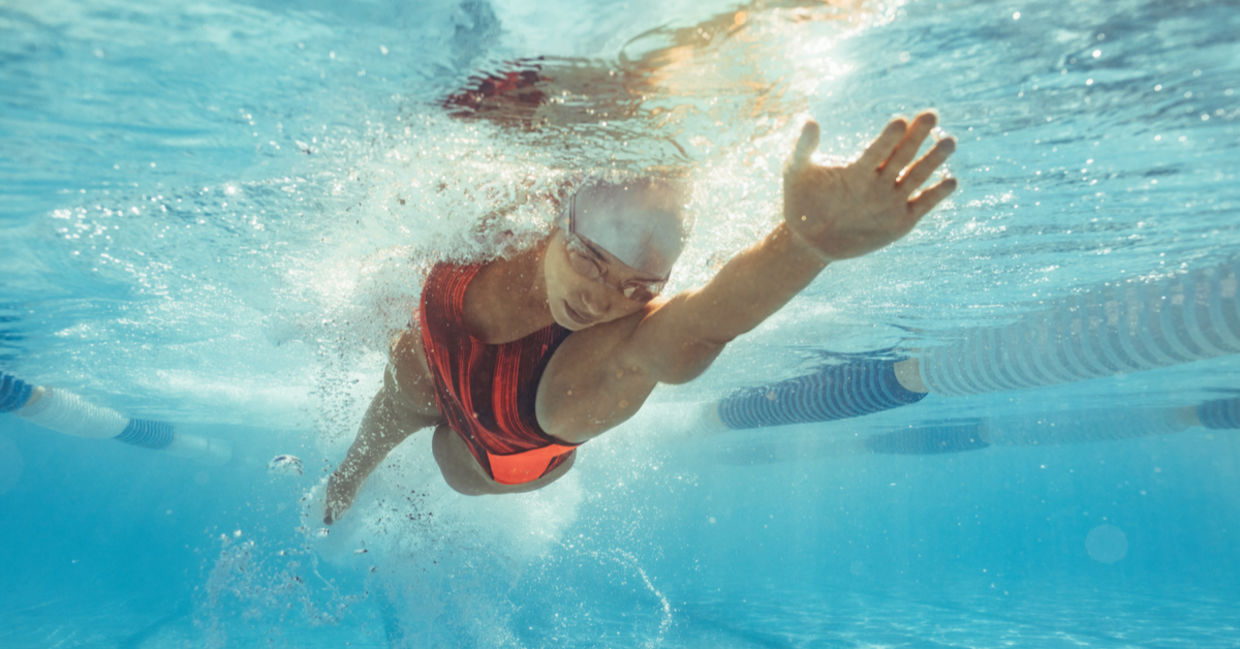
(Jacob Lund / Shutterstock.com)
Swimming is one of the best exercises around. It’s low-impact and easy on the joints, offers strength, as well as cardio training. Swimming can also help lower blood pressure, heart rate, and reduce cholesterol according to Shape.
But did you know doing laps is a form of mindful meditation? Introducing mindfulness into a swim workout helps people feel invigorated, alert, and refreshed both inside and out.
Many associate meditating with sitting in stillness on a pillow. Eyes are closed, legs are crossed, the room is silent. However, you can easily apply this concept to the local pool or lake. For those who prefer motion to stillness, swimming is a perfect way to exercise the body and clear the mind at the same time.
Competitive swimmer Tanya Nascimento wrote about mindful swimming in Swimming World Magazine: “Try to recognize your time swimming as a special time, somehow just for you, in spite of all your teammates engaged in the same activity. In other words, become aware of your surroundings and your bodily movement, without thought and without judgment, but rather with an attitude of serenity, control, and even awe.”
When swimming lengths, it is so easy to go into autopilot, becoming focused on the motion of the clock and the number of yards or lengths in a workout. For some, this may even turn swimming into a burden or a boring exercise. While there can be outside distractions such as music and the lifeguard’s whistle, mindful swimming enables you to dive internally and tune out external sights and sounds. Adding a mindful attitude can transform a dull, routine drill into a serene and calm practice.
Buddhist Door says that when you are mindfully swimming, total awareness begins as soon as you get into the water. You can first set a positive intention, then feel the water as it surrounds your body and notice how it feels on your skin. Immerse your head and breathe out slowly, becoming aware of the sound the small bubbles your exhale creates.
Kick off smoothly and glide. Focus on the sight of an arm reaching out in front and feel your legs kicking behind. If you are in a lake or the sea, be aware of how the sun glistens across the surface of the water and the rhythm of waves as they touch your face. If a sound jolts you or your mind starts to wander, accept the sound or thought without judging yourself and return to your breath.
When you are in the zone, Lexie Williamson explains in Gaia, mindful swimming, “is the ultimate, stripped-down moving meditation. The inability to see almost anything except the line at the bottom of the pool, and hear nothing but the rush of water, creates an insulating, cocooning effect.”
Being in this mindful state is important when living in a busy world of deadlines, stress and multitasking. There is precious little time, other than sleeping, to be completely alone with one’s self. Swimming is that time as it removes one from the tugs of the outside world, giving space to reconnect.
A swimming meditation enables you to feel good in the pool, but there are also benefits after you get out. When you master your breath, inhaling long and deeply, then exhaling slowly, chances are you will feel less anxiety and panic when stressors hit. Being mindful enables you to be expansive, calm, focused, and patient. Add when you add the happy endorphins that are released from exercising, you will also feel buoyed!
YOU MIGHT ALSO LIKE:
5 Ways to Practice Active Meditation if You Can’t Sit Still
Which Meditation is Best For You
How to Integrate Meditation into Your Busy Life







